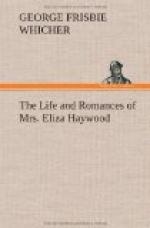The tender passion was still the theme in “Love-Letters on All Occasions Lately passed between Persons of Distinction,” which contains a number of letters, mainly disconnected, devoted to the warmer phases of gallantry. Some are essays in little on definite subjects: levity, sincerity, the pleasures of conjugal affection, insensibility, and so on. Most of them, however, are occasional: “Strephon to Dalinda, on her forbidding him to speak of Love,” “Orontes to Deanira, entreating her to give him a meeting,” and many others in which both the proper names and the situations suggest the artificial romances. None of the missives reveals emotions of any but the most tawdry romantic kind, warm desires extravagantly uttered, conventional doubts, causeless jealousies, and petty quarrels. Like Mrs. Behn’s correspondence with the amorous Van Bruin these epistles have nothing to distinguish them except their excessive hyperbole. There is one series of twenty-four connected letters on the model of “Letters from a Lady of Quality to a Chevalier,” relating the love story of Theano and Elismonda, but in the course of the whole correspondence nothing more momentous occurs than the lover’s leaving town. Indeed so imperceptible is the narrative element in Mrs. Haywood’s epistolary sequences that they can make no claim to share with the anonymous love story in letters entitled “Love’s Posy” (1686), with the “Letters Written By Mrs. Manley” (1696),[4] or with Tom Brown’s “Adventures of Lindamira” (1702) in twenty-four letters, the honor of having anticipated Richardson’s method of telling a story in epistolary form.[5]
Even after the publication of “Pamela” and “Clarissa” Mrs. Haywood failed to realize the narrative possibilities of consecutive letters, for “Epistles for the Ladies” (1749) hardly contains three missives on any one theme. Though the collection is not free from letters in the vein of gallantry, the emphasis on the whole is decidedly changed. There are few attempts to exploit the emotions by describing the palpitations of injured beauty or the expostulations and vows of love-sick cavaliers. Instead Aminta is praised for enduring with unusual self-possession the treachery of her lover and her most intimate friend. Sophronia encourages Palmira to persist in her resolution of living apart from her husband until she is convinced of the reformation of his manners, and Isabinda sends to Elvira a copy of a modest epithalamium on her sister’s marriage. Occasionally a romantic love story runs through three or four letters, but any deviation from the strictest principles of delicacy— and there are not many—is sure to be followed by a fitting catastrophe. Some reprobation of the licentious manners of the age is permitted, but no catering to degenerate taste and no breath of scandal. The aim of the epistles, which were apparently not intended as models, was to convey moral precepts in an agreeably alleviated form, but the balance inclines




